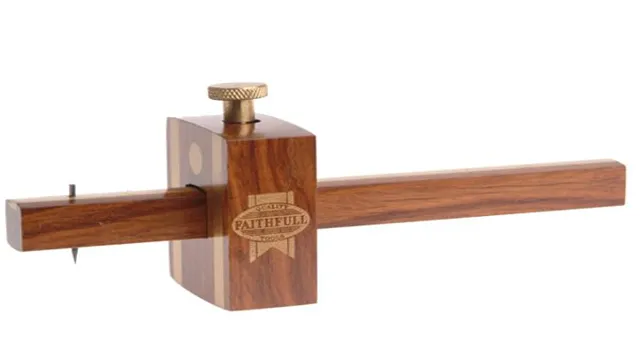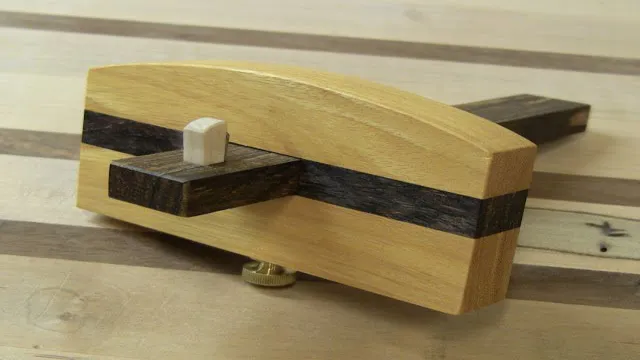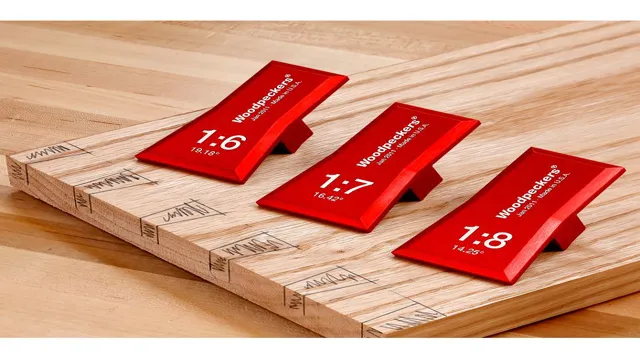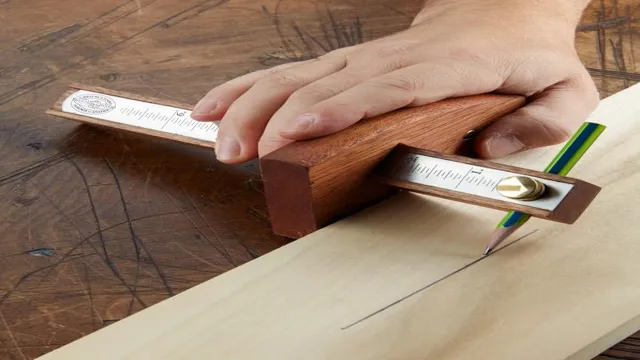What is the Difference Between Marking Gauge and Mortise Gauge: A Comprehensive Guide
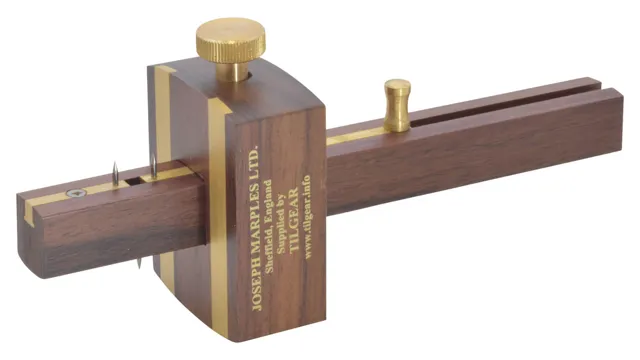
If you’re new to the woodworking world, the terminology can be overwhelming. One common issue for beginners is understanding the difference between marking gauges and mortise gauges. Both are essential tools for any woodworker, but they serve different purposes and have distinct features.
Marking gauges are handy for marking straight lines or parallel lines on a workpiece. Mortise gauges are specially designed for marking out mortises and tenons, making them a valuable tool for joinery. In this blog, we’ll delve into the intricate differences between the two and how to use them effectively to achieve professional results.
Overview of Gauges
Gauges are an essential tool for woodworkers that allow for precise measurements and markings. Two commonly used types of gauges are the marking gauge and mortise gauge. The main difference between the two is their purpose.
Marking gauges are primarily used to mark wood for cutting, while mortise gauges are used for measuring and marking out mortises, or slots made for joining pieces of wood. Another difference is the construction. Marking gauges typically have one marking point, while mortise gauges have two, along with an adjustable stop to ensure accuracy.
It’s important to understand the differences between these types of gauges to ensure that you’re using the correct tool for the job. So whether you’re marking out a new joint or sizing a piece of wood for cutting, knowing which gauge to use will make your woodworking projects more efficient and precise.
Explanation of a Marking Gauge
A marking gauge is a tool used in woodworking to create precise markings on a piece of wood. It consists of a beam with a marking wheel or blade on one end and a locking mechanism on the other. The blade or wheel can be adjusted to the desired distance from the edge of the workpiece and locked in place.
This allows for consistent and accurate measurements when marking out joinery or cutting lines. There are several types of gauges, including the mortise gauge, cutting gauge, and panel gauge, each with their own specific uses. The marking gauge is an essential tool in any workshop as it allows for precision and accuracy in woodworking projects.

Explanation of a Mortise Gauge
A mortise gauge is an essential tool for any woodworker looking to create precise and accurate joint cuts. Gauges, in general, are tools used to measure and mark dimensions on wood or other materials. A mortise gauge, in particular, is used to create parallel lines at a set distance from the edge of the wood.
It allows the woodworker to mark out two parallel lines that are exactly the width of the chisel, making it easier to create a mortise or tenon joint. The mortise gauge consists of a stock that holds a sliding beam, also called a fence. The beam has two small pins or points that are used to mark the wood.
By adjusting the distance between the pins or points, the woodworker can create parallel lines by running the fence along the edge of the wood. Overall, the mortise gauge is an indispensable tool for creating accurate and precise mortise and tenon joints, making it a must-have tool for any woodworker.
Differences Between Marking Gauge and Mortise Gauge
When it comes to woodworking, having the right tools is crucial. Two commonly used tools are the marking gauge and the mortise gauge. While they may look similar at first glance, there are some important differences to distinguish between the two.
In simple terms, a marking gauge is used to mark lines on a piece of wood, while a mortise gauge is used to mark out the dimensions of a mortise, which is a slot or recess in a piece of wood meant to receive a tenon. The main difference between the two is that a marking gauge has only one rod for making a single line, whereas a mortise gauge has two rods that can be adjusted to mark out the width and depth of the mortise. Overall, both tools are essential for any woodworker, but it’s important to understand their differences to choose the right tool for the job.
Purpose and Use
Marking Gauge and Mortise Gauge are two popular marking tools that carpenters and woodworkers use for various purposes. However, there are some key differences between the two that make them suitable for different tasks. The primary purpose of a marking gauge is to make parallel lines along the grain of the wood, while a mortise gauge is used to mark out the location of joints such as mortises and tenons.
A marking gauge usually has one marking point on the end, while a mortise gauge has two pins that can be adjusted to different distances apart. This makes the mortise gauge more versatile since it can be set up to mark out different sizes of mortises and tenons. As you can see, the main difference between these two gauges lies in their functionality and intended use.
While both are excellent tools for woodworking, they serve different purposes and are used in different ways.
Design and Features
When it comes to marking wood, two common tools that are often used are the marking gauge and the mortise gauge. Although both tools are primarily made for marking lines on wood, there are some differences that set them apart. For one, the mortise gauge is more versatile as it allows you to mark out the center of a mortise as well as both sides of a tenon.
On the other hand, the marking gauge is best suited for parallel cuts and can only make single lines. Additionally, the mortise gauge usually has two cutters, one that scribes the wood and the other that cuts into it. This ensures more accuracy and precision, especially when you’re marking out joinery.
Meanwhile, the marking gauge has a single cutter and is simpler in design. So, if you’re working on a project that requires more intricate joinery work, the mortise gauge is the better option. However, if you’re planning on making simple parallel cuts, a marking gauge will suffice.
At the end of the day, the choice between the two often boils down to the task at hand and personal preference.
Accuracy and Precision
When it comes to woodworking, accuracy and precision are crucial. Two tools commonly used to mark wood for cutting are the marking gauge and the mortise gauge. While both tools are designed to help woodworkers make precise cuts, there are some key differences between the two.
A marking gauge is a tool used to mark lines parallel to the edge of a board, whereas a mortise gauge is used to mark lines perpendicular to the edge of a board. The marking gauge has a single marking spur, while the mortise gauge has two. This makes the mortise gauge more versatile, as it can be used to mark out the width of mortises as well as the distance between them.
Another difference between the two tools is that the marking gauge has a fixed width, while the mortise gauge is adjustable. This makes the mortise gauge more flexible and able to adapt to different woodworking projects. Overall, both the marking gauge and the mortise gauge are essential tools for any woodworker looking to achieve precision and accuracy in their cuts.
By understanding the differences between these two tools, woodworkers can choose the right tool for the job and achieve the results they desire.
When to Use a Marking Gauge
Marking gauges and mortise gauges may look similar, but they have different purposes. A marking gauge is primarily used for marking lines on a piece of wood to ensure accurate cuts. It has a single marking point and a fence that runs along the wood, allowing the woodworker to maintain a consistent distance from the edge.
On the other hand, a mortise gauge has two marking points, which are used to mark out the width of a mortise or tenon. The points can be adjusted to the desired width, allowing for precision in the joinery. So, if you’re looking to mark out straight lines on your woodwork, a marking gauge would be the appropriate tool to use.
However, if you’re working with joinery and need to mark out mortises and tenons, a mortise gauge would be the better tool for the job. Knowing the difference between these tools and when to use them can make all the difference in the quality of your woodworking projects.
Types of Marking Gauges
Marking gauges are an essential tool in any woodworker’s arsenal. They are used to make precise markings on wood that serve as a guide for cutting, drilling, or shaping. There are several types of marking gauges available, including wheel, mortise, cutting, and panel gauges.
Each type has its own unique features and benefits, making them ideal for specific woodworking tasks. Knowing when to use a marking gauge depends on the project’s requirements and the type of wood being used. Marking gauges are particularly useful when working with hardwood, where precision is crucial.
They are also useful when working with complex joint designs that require precise measurements. For example, when creating mortise and tenon joints, a mortise gauge can be used to create the mortise’s exact size and location. When creating a panel overlay, a panel gauge can be used to mark the width of the panel’s edges accurately.
In addition to their precision and accuracy, marking gauges are also easy to use. They allow woodworkers to make uniform markings, ensuring each piece of wood is identical, resulting in a professional-looking finish. Marking gauges also allow for quicker and more efficient work by providing guidelines that eliminate the need for guessing and checking.
To conclude, a marking gauge is a vital tool for any woodworker looking to achieve precision and accuracy in their work. From creating mortise and tenon joints to marking panel overlays, marking gauges make woodworking projects more manageable and efficient.
Best Uses for a Marking Gauge
A marking gauge can be an incredibly useful tool for woodworkers, especially when precision is key. One of the best uses for a marking gauge is when marking out joints such as mortises and tenons. By using the marking gauge, you can ensure that your cuts are accurate and consistent, leading to a better fit overall.
It can also be helpful when marking out the location of hinges or other hardware, ensuring that everything lines up perfectly. When working with multiple pieces of wood, a marking gauge can be used to mark out identical measurements on each piece, reducing the risk of errors and inconsistencies. Overall, a marking gauge is an essential tool for any woodworker looking to achieve precise and professional-looking results.
When to Use a Mortise Gauge
When it comes to woodworking, having the right tools is crucial to achieving accurate and seamless cuts. One commonly used tool is the marking gauge, which is ideal for marking wood along a straight edge. However, when it comes to creating mortise and tenon joints, a mortise gauge proves to be much more efficient and accurate than a marking gauge.
The main difference between the two is that a mortise gauge has two pins that can be adjusted to create two parallel lines, perfect for marking out the width of a tenon. On the other hand, a marking gauge only has one pin and only marks one line at a time. When it comes to the question of what is the difference between marking gauge and mortise gauge, the answer is clear: while a marking gauge is useful for general marking purposes, a mortise gauge is essential when creating precise and intricate joinery.
So, when it comes to the task at hand, it is essential to use the correct gauge to achieve a high-quality result.
Conclusion
In the world of woodworking, the difference between a marking gauge and a mortise gauge may seem subtle, but it ultimately boils down to the type of groove they create. A marking gauge’s tiny incisions act as a set of breadcrumbs, guiding the woodworker along their intended path, while a mortise gauge cuts a deeper and wider groove, allowing for more precise measurements and delicate adjustments. So, in other words, a marking gauge is like a helpful signpost while a mortise gauge is more like Jimmy Stewart’s character in Rear Window: precise and methodical, but still human and prone to mistakes.
“
FAQs
1. What is a marking gauge and how is it different from a mortise gauge? A: A marking gauge is a woodworking tool used to make precise marks on a workpiece, while a mortise gauge is a type of marking gauge specifically designed for making marks for mortise and tenon joints. 2. Can a marking gauge be used for mortise and tenon joints? A: While a marking gauge can technically be used for mortise and tenon joints, a mortise gauge is specifically designed for this purpose and makes the process much easier and more precise. 3. How does a mortise gauge work? A: A mortise gauge consists of two pins that can be adjusted to the desired width of the mortise, which are then used to scribe lines on the workpiece for the mortise joint. 4. What are the advantages of using a mortise gauge over a marking gauge? A: A mortise gauge is designed specifically for making mortise and tenon joints, resulting in more precise and accurate markings. It also saves time and effort compared to using a marking gauge and trying to adjust the pins or blade for each marking. 5. Can a mortise gauge be used for other types of woodworking projects besides mortise and tenon joints? A: Yes, a mortise gauge can be used for any project that requires precise markings, such as for making dovetail joints or other intricate cuts. 6. What materials are commonly used to make marking and mortise gauges? A: Marking and mortise gauges are typically made of wood, metal, or a combination of both. Some modern versions may incorporate plastic or other materials as well. 7. How do you properly use a marking or mortise gauge? A: To use a marking or mortise gauge, adjust the pins or blade to the desired measurement, then use the tool to scribe lines on the workpiece. It’s important to hold the tool securely and maintain a consistent pressure and angle for accurate markings.

